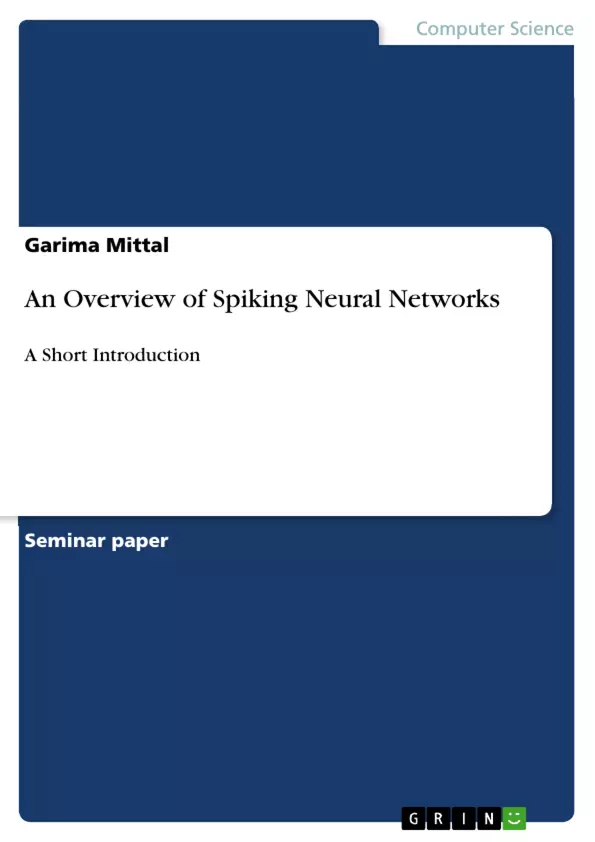This work gives an introduction to SNNs and the underlying biological concepts. It gives an overview and comparison of some of the more commonly used SNN models. It discusses the scope of SNNs and some of the areas where they have been applied so far. Spiking neural networks or SNNs are inspired by the biological neuron. They are the next step towards the goal of replicating the mammalian brain in computational speed, efficiency and energy consumption.
First generation artificial neural networks (ANNs) or Perceptron use a [0,1] binary threshold function to approximate digital input and allow for linear classification. Second generation ANNs like multi-layer perceptron, feed-forward and recurrent neural networks use continuous activation functions like sigmoid which can approximate analog functions. Spiking neural networks, introduced by Hopfield in 1995, are third generation ANNs and aim at higher biological plausibilty than the first and second generations by including time intrinsically. They use the precise firing times of neurons to code information. SNNs are modelled on the biological neuron. It is therefore important to understand the basic biological concepts underlying SNNs.
Inhaltsverzeichnis (Table of Contents)
- I. INTRODUCTION
- A. Membrane Potential
- B. Action Potential
- C. Time as the basis of information coding
- II. SPIKING NEURAL NETWORK MODELS
- A. Threshold-Fire Models
- 1) Integrate-and-Fire (I&F) Model:
- 2) Leaky-Integrate-and-Fire (LIF) Model:
- 3) Spike Response Model (SRM):
- B. Conductance-based Models
- Hodgkin-Huxley (HH) Model:
- A. Threshold-Fire Models
- III. COMPARING SNN MODELS
- IV. APPLICATIONS OF SNNS
- A. Cognitive Hardware
- B. Vision-based applications
- C. Analysis of spatio-temporal data
- D. Other areas
- V. SUMMARY
Zielsetzung und Themenschwerpunkte (Objectives and Key Themes)
This work provides an introduction to spiking neural networks (SNNs), exploring their biological inspiration and comparing different SNN models. It examines the potential of SNNs in various applications, highlighting their advantages and limitations.
- Understanding the biological basis of SNNs
- Exploring different SNN models and their characteristics
- Analyzing the strengths and weaknesses of SNNs in various applications
- Evaluating the potential of SNNs for future development and research
- Comparing SNNs to traditional artificial neural networks
Zusammenfassung der Kapitel (Chapter Summaries)
I. INTRODUCTION introduces the concept of SNNs, highlighting their biological inspiration and the use of time as a coding mechanism. It discusses the limitations of traditional artificial neural networks and how SNNs aim to overcome these limitations. The chapter then delves into the biological concepts underlying SNNs, explaining the membrane potential, action potential, and the role of time in information coding.
II. SPIKING NEURAL NETWORK MODELS categorizes and describes different SNN models based on their underlying principles. It covers both threshold-fire models like Integrate-and-Fire (I&F), Leaky-Integrate-and-Fire (LIF), and Spike Response Model (SRM), as well as conductance-based models like the Hodgkin-Huxley (HH) model. The chapter discusses the advantages and limitations of each model in terms of biological plausibility and computational efficiency.
III. COMPARING SNN MODELS analyzes the trade-off between biological plausibility and computational efficiency in different SNN models. It explores the challenges of simulating complex models and the need for a hybrid approach that balances biological accuracy and computational feasibility.
IV. APPLICATIONS OF SNNS explores various application areas of SNNs, such as cognitive hardware, vision-based applications, analysis of spatio-temporal data, and other emerging applications. It discusses the potential of SNNs in areas like neuromorphic computing, image recognition, speech recognition, and robot navigation.
Schlüsselwörter (Keywords)
This preview focuses on spiking neural networks (SNNs), their biological inspiration, different SNN models, computational efficiency, biological plausibility, neuromorphic computing, applications in image recognition, speech recognition, and robot navigation, and the analysis of spatio-temporal data.
- Quote paper
- Garima Mittal (Author), 2018, An Overview of Spiking Neural Networks, Munich, GRIN Verlag, https://www.grin.com/document/921629



